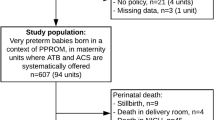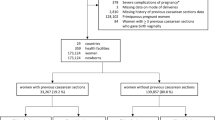Abstract
Objective:
To investigate whether the national emphasis on attaining ⩾39 weeks gestation has altered obstetric practice, and if so whether this has affected perinatal morbidity.
Study Design:
We examined trends in gestational age, neonatal morbidity, maternal complications and stillbirth for a retrospective cohort of singleton, live births between 37+0 and 39+6 weeks of gestation over a 5-year period at a single tertiary care center.
Result:
There were 21 343 eligible deliveries. The proportion of deliveries in the early term (<39 weeks) decreased from 47.8 to 40.2% (P<0.01). The reduction was most pronounced for elective inductions (27.5 to 8.0%; P<0.01) and scheduled cesareans (56.9 to 24.9%; P<0.01), although a similar trend was seen for nonelective inductions (51.2 to 47.9%; P=0.03). In multivariable analysis, there was a 10% decreased odds of early term delivery per year (P<0.01). There were no changes in the rates of neonatal intensive care unit (NICU) evaluation (29.8 to 28.1%; P=0.11), pre-eclampsia (7.6 to 8.5%; P=0.06) or stillbirth (11.5 to 14.4 per 10 000; P=0.55).
Conclusion:
A 10% annual decline in the odds of early term delivery was not accompanied by significant changes in perinatal morbidity.
This is a preview of subscription content, access via your institution
Access options
Subscribe to this journal
Receive 12 print issues and online access
$259.00 per year
only $21.58 per issue
Buy this article
- Purchase on Springer Link
- Instant access to full article PDF
Prices may be subject to local taxes which are calculated during checkout


Similar content being viewed by others
References
Tita AT, Landon MB, Spong CY, Lai Y, Leveno KJ, Varner MW et al. Timing of elective repeat cesarean delivery at term and neonatal outcomes. N Engl J Med 2009; 360: 111–120.
Clark SL, Miller DD, Belfort MA, Dildy GA, Frye DK, Meyers JA . Neonatal and maternal outcomes associated with elective term delivery. Am J Obstet Gynecol 2009; 200: 156. e1–4.
Ghartey K, Coletta J, Lizarraga L, Murphy E, Ananth CV, Gyamfi-Bannerman C . Neonatal respiratory morbidity in the early term delivery. Am J Obstet Gynecol 2012; 207 (4): 292. e1-4.
Zhang X, Kramer MS . Variations in mortality and morbidity by gestational age among infants born at term. J Pediatr 2009; 154: 358–362.
Yang S, Platt RW, Kramer MS . Variation in child cognitive ability by week of gestation among healthy term births. Am J Epidemiol 2010; 171: 399–406.
Chiossi G, Lai Y, Landon MB, Spong CY, Rouse DJ, Varner MW et al. Timing of delivery and adverse outcomes in term singleton repeat cesarean deliveries. Obstet Gynecol 2013; 121: 561–569.
Induction of labor. ACOG Practice Bulletin No. 107. American College of Obstetricians and Gynecologists. Obstet Gynecol 2009; 114: 386–397.
Medically indicated late-preterm and early-term deliveries. ACOG committee opinion no. 560. American College of Obstetricians and Gynecologists. Obstet Gynecol 2013; 121 (4): 908–910.
Specifications Manual for Joint Commission National Quality Core Measures [Version 2011A]. Oakbrook Terrace (IL): The Joint Commission; 2010 Dec. PC-1 to PC-242 p.
Main E, Oshiro B, Chagolla B, Bingham D, Dang-Kilduff L, Kowalewski L Elimination of Non-medically Indicated (Elective) Deliveries Before 39 Weeks Gestational Age. (California Maternal Quality Care Collaborative Toolkit to Transform Maternity Care) Developed under contract #08-85012 with the California Department of Public Health; Maternal, Child and Adolescent Health Division; First edition published by March of Dimes 2010.
Donovan EF, Lannon C, Bailit J, Rose B, Iams JD, Byczkowski T . Ohio Perinatal Quality Collaborative Writing Committee. A statewide initiative to reduce inappropriate scheduled births at 36(0/7)-38(6/7) weeks' gestation. Am J Obstet Gynecol 2010; 202 (3): 243. e1–e8.
Ehrenthal DB, Hoffman MK, Jiang X, Ostrum G . Neonatal outcomes after implementation of guidelines limiting elective delivery before 39 weeks of gestation. Neonatal outcomes after implementation of guidelines limiting elective delivery before 39 weeks of gestation. Obstet Gynecol 2011; 118 (5): 1047–1055.
Oshiro BT, Henry E, Wilson J, Branch DW, Varner MW . Women and Newborn Clinical Integration Program. Decreasing elective deliveries before 39 weeks of gestation in an integrated health care system. Obstet Gynecol 2009; 113 (4): 804–811.
Mukhopadhyay S, Eichenwald EC, Puopolo KM . Neonatal early-onset sepsis evaluations among well-appearing infants: projected impact of changes in CDC GBS guidelines. J Perinatol 2013; 33 (3): 198–205.
Acknowledgements
This research was presented orally (abstract no. 27) at the 33rd Annual Meeting of the Society for Maternal-Fetal Medicine, San Francisco, CA, 11 to 16 February 2013.
Author information
Authors and Affiliations
Corresponding author
Ethics declarations
Competing interests
The authors declare no conflict of interest.
Rights and permissions
About this article
Cite this article
Little, S., Robinson, J., Puopolo, K. et al. The effect of obstetric practice change to reduce early term delivery on perinatal outcome. J Perinatol 34, 176–180 (2014). https://doi.org/10.1038/jp.2013.166
Received:
Revised:
Accepted:
Published:
Issue Date:
DOI: https://doi.org/10.1038/jp.2013.166
Keywords
This article is cited by
-
Prenatal Congenital Heart Disease—It Takes a Multidisciplinary Village
Pediatric Cardiology (2023)
-
Variation in clinical decision-making for induction of labour: a qualitative study
BMC Pregnancy and Childbirth (2017)
-
A Statewide Quality Improvement Initiative to Reduce Non-Medically Indicated Scheduled Deliveries
Maternal and Child Health Journal (2017)
-
Early term infants are at increased risk of requiring neonatal intensive care
World Journal of Pediatrics (2016)



